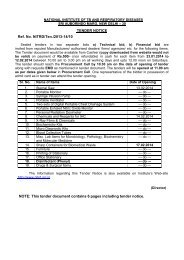The Indian Journal of Tuberculosis - LRS Institute of Tuberculosis ...
The Indian Journal of Tuberculosis - LRS Institute of Tuberculosis ...
The Indian Journal of Tuberculosis - LRS Institute of Tuberculosis ...
You also want an ePaper? Increase the reach of your titles
YUMPU automatically turns print PDFs into web optimized ePapers that Google loves.
Continuing Medical Education Ind. L Tub., 1992, 39, 53<br />
TUBERCULIN SKIN TEST*<br />
A.N. Sashidhara 1 and K. Chaudhuri 2<br />
Introduction<br />
<strong>The</strong> tuberculin skin test has a 100 year old<br />
chequered history. Its use and validity were very<br />
different at the start compared with what they are<br />
today.<br />
After the discovery <strong>of</strong> the tubercle bacillus in<br />
1882, Robert Koch began experimenting with its<br />
growth on culture media in the laboratory. By<br />
1890, he had developed a brownish, transparent,<br />
broth culture filtrate which he named “tuberculin”.<br />
Soon followed his announcement that tuberculin<br />
“protected against tuberculosis in guinea<br />
pigs, and had a specific healing effect on tuberculosis<br />
processes <strong>of</strong> all kinds in human beings”,<br />
which claim proved to be baseless. However, his<br />
observation that the “subcutaneous inoculation <strong>of</strong><br />
tuberculin in a tuberculous patient led to a rise in<br />
temperature and local reaction at the inoculation<br />
site, whereas it had no such effect on the non-tuberculous”<br />
laid the foundation at that time, for its<br />
use in the diagnosis <strong>of</strong> tuberculosis. However,<br />
neither a standard tuberculin preparation nor a<br />
uniform technique for testing was developed.<br />
In 1907, Von Pirquet demonstrated that on<br />
skin “a tiny scratch made through a little quantity<br />
<strong>of</strong> tuberculin.... produced evidence <strong>of</strong> tuberculin<br />
sensitivity”, which observation was the next step<br />
in the long journey towards the present day tuberculin<br />
test. In 1908, Charles Mantoux used a syringe<br />
to administer a measured quantity <strong>of</strong> tuberculin,<br />
at a desired depth in the skin (Mantoux<br />
test), which has since become the standard procedure<br />
for doing the tuberculin skin test. No doubt,<br />
several other methods for doing the test have<br />
been developed but none can be standardized,<br />
qualitatively and quantitatively, as is possible with<br />
the Mantoux test.<br />
In order that the test could be used, by clinicians<br />
to identify persons at a higher risk <strong>of</strong> developing<br />
tuberculosis and epidemiologists to meas-<br />
ure the extent <strong>of</strong> tuberculosis infection in the<br />
community, Carrol E. Palmer and his co-workers<br />
identified, around 1950, most <strong>of</strong> the shortcomings<br />
<strong>of</strong> the tuberculin skin test, and developed ways to<br />
overcome them. <strong>The</strong>ir monumental researches<br />
led to the desired standardization <strong>of</strong> the test, thus<br />
retaining its value as a reference test for other<br />
competing tuberculin tests. <strong>The</strong>y showed that a<br />
significant reaction (say > 10 mm) merely indicated<br />
infection with M. tuberculosis, and the person<br />
being at a higher risk <strong>of</strong> developing the disease.<br />
<strong>The</strong> isolation <strong>of</strong> tubercle bacillus, from a<br />
specimen obtained from a person and/or detection<br />
<strong>of</strong> characteristic tissue changes in a biopsy<br />
specimen was essential to establish the definitive<br />
diagnosis. In other words, even the currently used<br />
standard tuberculin skin test has shortcomings,<br />
which are being overcome by a very careful interpretation<br />
<strong>of</strong> the results, making it a very valuable<br />
epidemiological tool, but hardly a-diagnostic test.<br />
Tuberculins<br />
Currently, two main tuberculin preparations<br />
are in use:<br />
Old Tuberculin (OT) which is a M tuberculosis<br />
broth culture, containing soluble portions<br />
<strong>of</strong> the used culture medium and lysis<br />
products <strong>of</strong> one or more strains <strong>of</strong> the bacillus,<br />
filtered and concentrated to a desired<br />
volume; and<br />
Purified Protein Derivative (PPD) which is<br />
a pure mixture <strong>of</strong> protein polysaccharides<br />
derived from the bacillus by a process<br />
developed by Seibert et al.<br />
<strong>The</strong> OT is a crude product containing many<br />
extraneous agents that produce cross reactions to<br />
many mycobacteria <strong>of</strong> non-tuberculosis type. <strong>The</strong><br />
composition and quantities <strong>of</strong> the active principles<br />
in different preparations <strong>of</strong> OT are never<br />
* Abridged and condensed from : <strong>The</strong> Tuberculin Skin Test - Emerging 100 years since its first use\ NTI Newsletter<br />
(1990), 26, 1 & 2, Supplement.<br />
1. Investigator; 2. Director, National <strong>Tuberculosis</strong> <strong>Institute</strong>, 8, Bellary Road, Bangalore- 560 003.

















